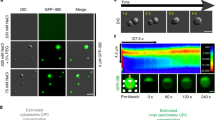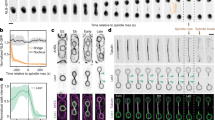Abstract
THE persistence of the centriole during interphase near the nucleus within the so-called cell centre seems to be a general feature of most animal cells. An association between the nucleus and the cell centre has been proposed and has been clearly shown in some cell types1,2. A permanent system involving chromosomes, spindle fibres and centrioles has been suggested by Lettre et al.3, and Aronson4 has demonstrated the existence of a Colcemid-sensitive mobile system between the nucleus and a centre at the two-cell stage in the sea urchin Lytechinus variegatus. We show here that there is a physical association between the centriole and the nucleus in the rat liver cell which resists cold treatment, cell disruption and nuclear isolation. When nuclear envelopes are prepared from isolated nuclei, the association between the centriole and the nuclear envelope is maintained.
This is a preview of subscription content, access via your institution
Access options
Subscribe to this journal
Receive 51 print issues and online access
$199.00 per year
only $3.90 per issue
Buy this article
- Purchase on Springer Link
- Instant access to full article PDF
Prices may be subject to local taxes which are calculated during checkout
Similar content being viewed by others
References
Bessis, M. & Breton-Gorius, J. Nouvelle Rev. Française Hematologie 7, 601–620 (1967).
Rondanelli, E. G., Carosi, G., Gerna, G. & Magliulo, E. Acta Anat. 70, 85–98 (1968).
Lettre, M. & Lettre, R. Rev. Hemat. 13, 337–362 (1958).
Aronson, J. F. J. Cell Biol. 51, 579–583 (1971).
Blobel, G. & Potter, V. R. Science 154, 1662–1665 (1966).
Bornens, M., Nature 244, 28–30 (1973).
Bornens, M. Meth. Cell Biol. 15, 163–175 (1977).
Dauta-Mentre, P. J. Microscopie 3, 607–626 (1964).
Olins, D. E. & Olins, A. L. J. Cell Biol. 53, 715–736 (1972).
Prescott, D. M., Myerson, D. & Wallace, J. Expl Cell Res. 71, 480–485 (1972).
Prescott, D. M. & Kirkpatrick, J. B. Meth. Cell Biol. 7, 189–202 (1973).
Wise, G. E. & Prescott, D. M. Expl Cell Res. 81, 63–72 (1973).
Shay, J. W., Porter, K. R. & Prescott, D. M. Proc. natn. Acad. Sci. U.S.A. 71, 3059–3063 (1974).
Goldman, R. D., Pollack, R., Chang, C. M. & Bushnell, A. Expl Cell Res. 93, 175–183 (1975).
Wright, W. E. & Hayflick, L. Proc. Soc. exp. Biol. Med. 144, 587–592 (1973).
Carter, S. B. Nature 213, 261–264 (1967).
Author information
Authors and Affiliations
Rights and permissions
About this article
Cite this article
BORNENS, M. Is the centriole bound to the nuclear membrane?. Nature 270, 80–82 (1977). https://doi.org/10.1038/270080a0
Received:
Accepted:
Issue Date:
DOI: https://doi.org/10.1038/270080a0
This article is cited by
-
The centrosome is an actin-organizing centre
Nature Cell Biology (2016)
-
Mouse granzyme A induces a novel death with writhing morphology that is mechanistically distinct from granzyme B-induced apoptosis
Cell Death & Differentiation (2013)
-
Molecular mechanisms of centrosome and cytoskeleton anchorage at the nuclear envelope
Cellular and Molecular Life Sciences (2011)
-
Organelle positioning and cell polarity
Nature Reviews Molecular Cell Biology (2008)
-
Intermediate filaments anchor the nuclei in nuclear monolayers of cultured human fibroblasts
Nature (1978)
Comments
By submitting a comment you agree to abide by our Terms and Community Guidelines. If you find something abusive or that does not comply with our terms or guidelines please flag it as inappropriate.



